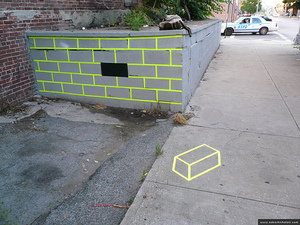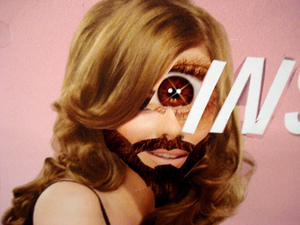This is an archive of the ArtCat Zine, 2007-2009. Please visit our new project, IDIOM.
Re:Public, Masters of the Ephemeral
Editor's note: Re:Public is H.V.'s a new column on ArtCal covering contemporary street art in New York City.
Re:Public, Masters of the Ephemeral
If the world of street art is mercurial then it should come as no surprise that the art of two of downtown's most visible artists are as ephemeral as the urbanscape.
Poster Boy may be new to the game but he has already attracted much attention for his precise mash-ups of advertising and signage. Using a razor, he targets mainstream advertising images which he remixes into funny and absurd commentaries on life, culture and politics. He admits that he has long vandalized posters but more recently his reformatting of corporate propaganda is being honed to cleverly subvert its original message. His Flickr page surfaced only a few months ago and it is definitely provides the easiest access for his hybrid work.
Why does he do it? "I do it for a few reasons," he tells me over email. "A: I can barely afford art materials. B: I don't like the media bombarding me with bullshit everywhere I go. C: I like to see the public react to my work."
Though nothing appears sacred to him, Poster Boy does make a point to target ads that piss him off the most. The only people who seem to take exception to his work tend to be agents of the municipal surveillance industry: the NYPD and MTA workers. He knows that it can be quite jarring for many people to spot a razor-wielding figure on the subway platform but he sees them relax when they realize he's only interested in artistic mayhem.
"I don't want Poster Boy to be about one person. They're never signed, unless you consider the Flickr page my signature, so that any piece can belong to anyone. A lot of people say I'm a sucker for not trying to make money off Poster Boy, but I still feel rewarded. However, I'd like to make a book of the best pieces from '08. Who knows how well that'll turn out?" he says.
Another street artist who has been creating marginal street art works is Aakash Nihalani, who doesn't use a nickname like so many other street talents. He fashions cubes out of colorful tape throughout Brooklyn and Manhattan. He explains why the box appeals to him and why he shies away from variations of his beloved form: "We live in a big city of big boxes with little windows peeking onto other big boxes next to smaller ones, and so on. The shape, the image I employ, is New York. I guess I feel like there's a certain sense of forgotten dimension, a lot of overlooked layers. So I create reminders and portals with the cubes, adding to the urban landscape. It just makes sense."
The notion of meaning in Nihalani's work is as nebulous as the nature of his artistic material: industrial tape. Unlike other street artists who leave residue of their activity after its removal (glue, color), Nihalani's works completely disappear. He navigates a fine line between vandalism and littering that even the cops don't know how to deal with. "So far no arrests," he says sounding relieved, "though last week I had a couple cops pull up while I was doing a sidewalk piece saying they got calls about suspicious activity. They made me take it off, and said, 'Take it to the park.' I think it is regarded as marginal by both sides, a kind of polite graffiti. But I've heard of detainment for chalk 'graff,' so I dunno sometimes with these guys."
He tells me he can spot a good location by the colors and architecture of a place. Instinct drives his work and, like Poster Boy, there isn't any premeditated planning; he prefers to riff off the vibe at the site where he works. "There are the times where a scenario catches me, a platform violinist, a preaching panhandler, a sleeping drunk. Honestly there are too many to do. I think that goes for most street artists," he says.
Nihalani thinks most people, with the exception of a few in uniforms, like his work. Only when he invades someone's space, like when he "boxes" in a person sleeping on the street, does he attract cautious, sometimes negative, attention.
"I want to bring something new to street art, or rather, I want people to get something new from street art. Not just a sight seeing game, but a physically, intellectually, and emotionally engaging opportunity. I think I try to highlight the possibilities in my documentations at www.aakashnihalani.com," he says. "There's a certain magic, I've found, about working in collaboration with the street environment, making aesthetic decisions in the middle of a piece, in the middle of the street."
"As a painter I had a lot of frustration with the hermetic, formulaic life of paintings -- studio to storage. The tape gives me a chance to let my art live, I get to feel the effects of what it means to make art. I don't have to have a relationship with a gallery to reach people. I mean, I think the tape, as a medium, has a ton of aspects that allow me to work differently, freer, in more places. But I'll never stop painting on canvas."
Coincidentally, the two street mavericks started to collaborate earlier this month and have started producing, in true street art fashion, combo pieces that are a departure for both New Yorkers.
"I fucking love his work," Nihalani says about Poster Boy, and the feeling is mutual according to the latter. "I met Poster Boy a few years ago while I was in school... we shared a creative imperative that art could, and should, be made anywhere and everywhere. After we both broke out of the studio to make art, we started planning a collaboration, and we finally just got around to doing it. I thoroughly enjoyed the experience and the results. We're planning the next session."
If the general wisdom in the street art scene is that the golden age for the genre has passed, Poster Boy and Nihalani are proving that it may only be the rules of the game that have changed. A new breed of street artist is creating art that resists commodification, objects that live on democratically as images on the web. Their messages might be literal or abstract but their appeal is universal.
ZINE
HOME
TIPS / COMMENTS
CATEGORIES
CONTRIBUTORS
- Greg Afinogenov
- B. Blagojevic
- Adda Birnir
- Susannah Edelbaum
- Julie Fishkin
- Paddy Johnson
- Jessica Loudis
- Christopher Reiger
- Andrew Robinson
- Peter J. Russo
- Blythe Sheldon
- S.C.Squibb
- Hrag Vartanian


